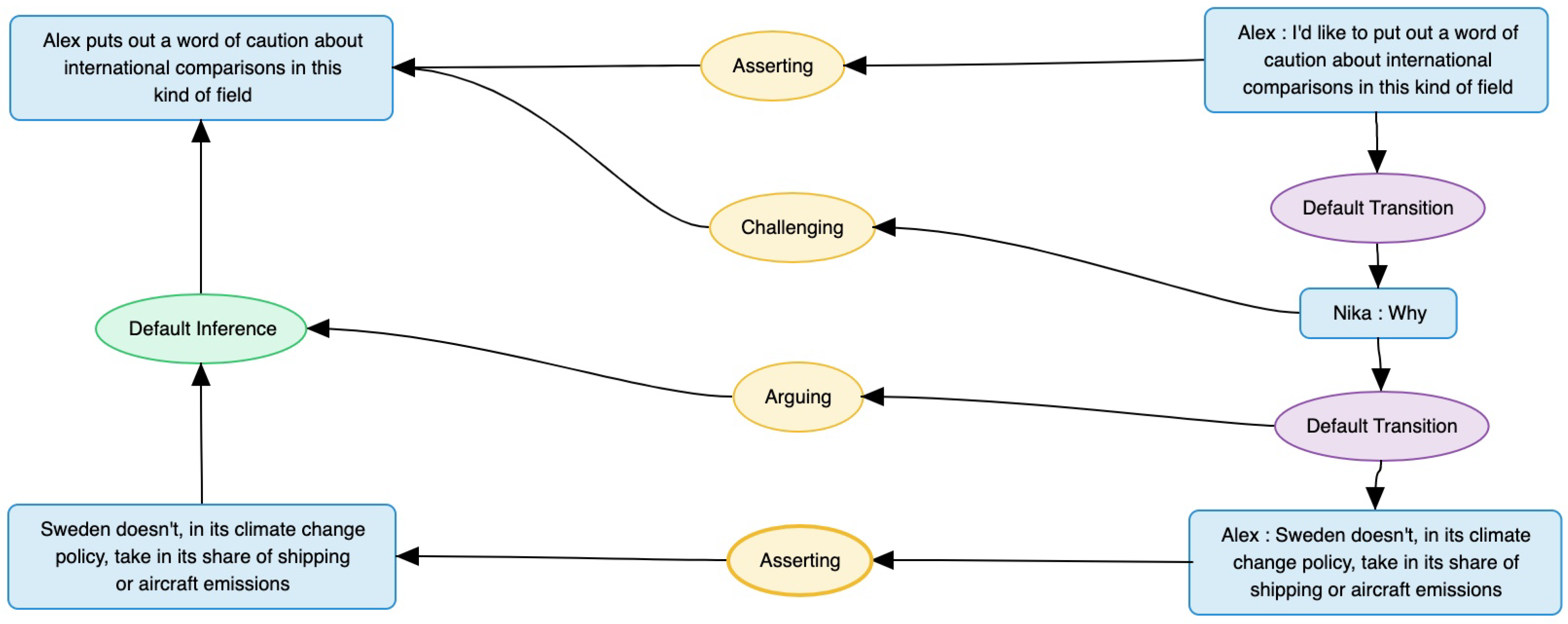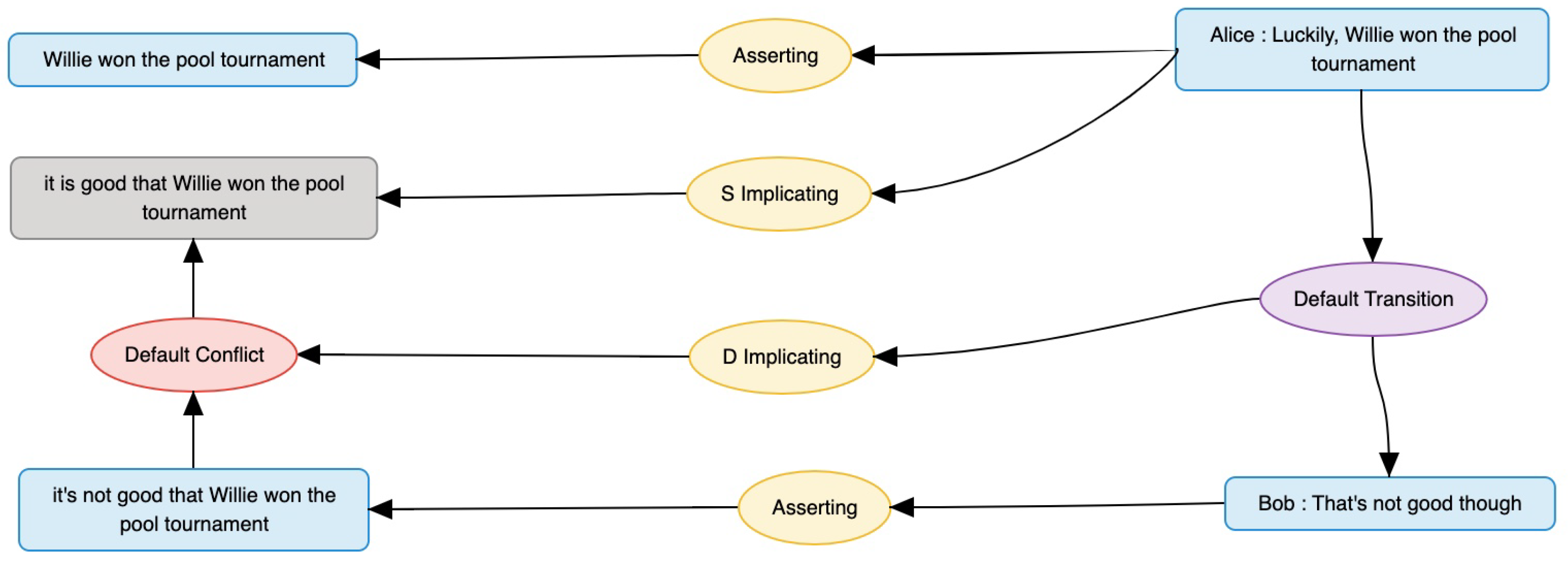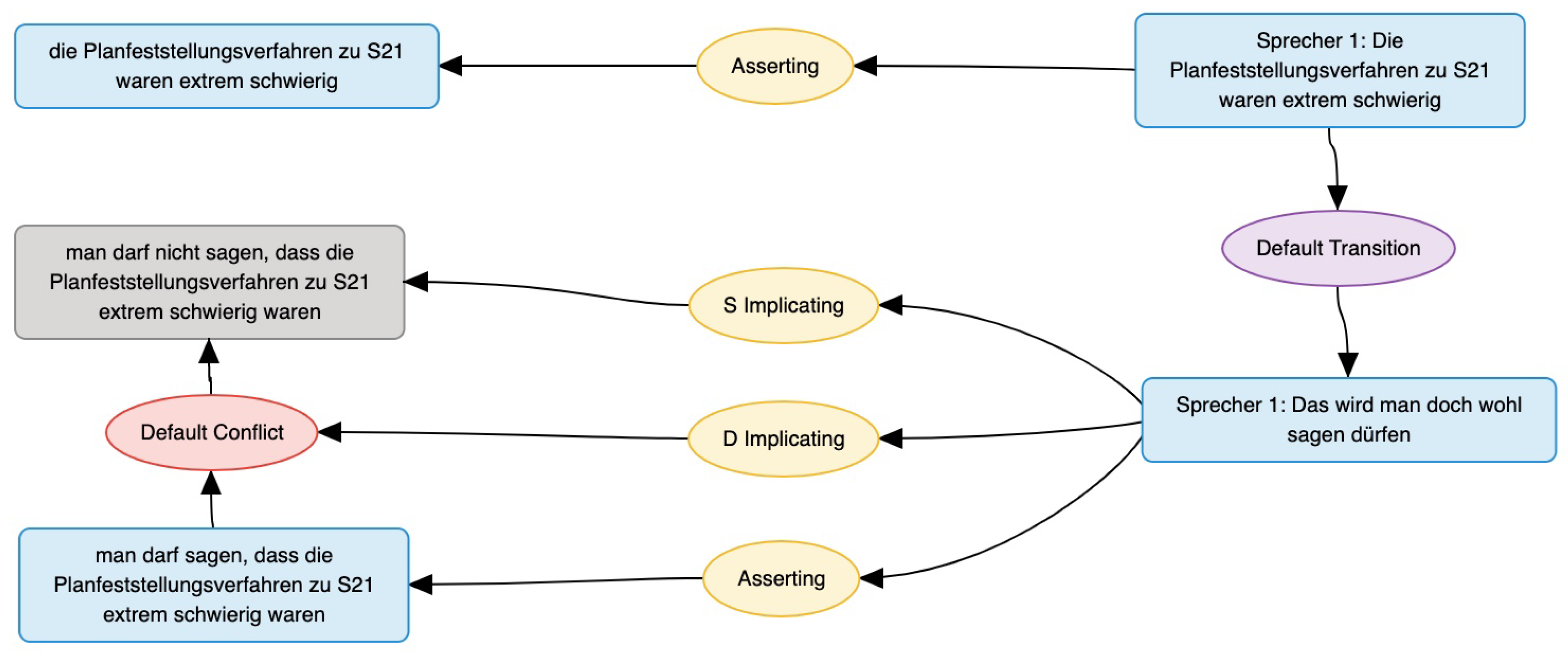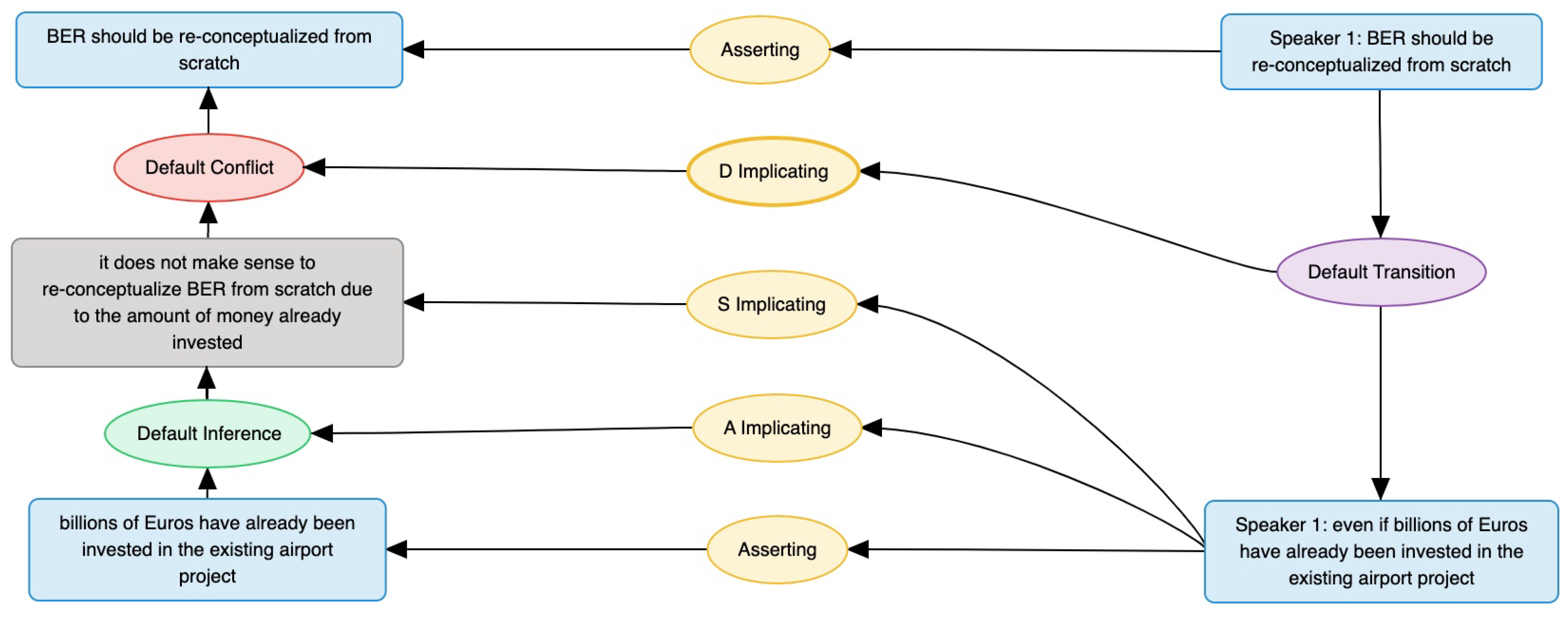1. Introduction
Implicitness is central in argumentation: not only is the vast majority of argument relations implicit—only 4% of arguments are signaled with explicit linguistic cues such as discourse markers (
Lawrence and Reed 2015)—but implicitness can also serve specific discursive purposes: it can increase the rhetorical force of the argument, conceal its unsoundness and keep the listener’s attention (
Hurley 2014), it can increase the possibility of gaining the listener’s agreement (
Jackson and Jacobs 1980) and increase persuasion performance (
Lombardi Vallauri 2021, among many others). It is therefore crucial to unpack implicit argumentative structure for identifying the subtle structure of a debate and the relations with which participants connect to the content under discussion and their interlocutors.
In this paper, we take a closer look at the role and function of conventional implicatures (
cis) in dialogical argumentation. Originally introduced by
Grice (
1975) as anything that is inferred from an utterance and not a condition for the truth of the utterance,
cis since then had a long and troubled history in the philosophy of language (
Bach 1999;
Grice 1975;
Karttunen and Peters 1979;
Potts 2005, inter alia).
Potts (
2005) establishes a number of clear-cut criteria as to their status in relation to other types of inferences such as presuppositions, entailments and conversational implicatures:
cis have an anchor on the linguistic surface, are characterised by a high degree of speaker commitment and are logically and compositionally independent of at-issue content. Originally, were introduced in connection with discourse connectors signalling argumentation—see Grice’s classic example with ‘therefore’ in (1) (
Grice 1975, p. 44): Grice claims that while the information of being an Englishman and being brave is asserted—“or said (in the favoured sense)” (
Grice 1975, p. 45)—the consequence of being brave following from being an Englishman is “indicated, and so implicated”.
- (1)
He is an Englishman, he is, therefore, brave.
cis can also arise structurally, for example with fronted adverbial clauses as in (2-a) taken from (
Potts 2005, p. 139) with ‘luckily’: Wilma’s assertion in (2-a) is that Willie won the pool tournament. With the
ci triggered by the sentence-initial adverb ‘luckily’ she contributes a proposition along the lines of ‘Willie winning the pool tournament is positive’. By adding Bob’s reply in (2-b) (‘That’s not good though’), an argumentative structure arises: Bob’s assertion that Willie winning the pool tournament is not good in (2-b) is in conflict with Wilma’s conventional implicature in (2-a).
| (2) | a. | Wilma: Luckily, Willie won the pool tournament. |
| b. | Bob: That’s not good, though. |
Overall, the linguistic material that triggers
cis is highly varied: from expressives (e.g., ‘damn’, ‘fucking’) (
Potts 2005), slifting verbs (‘Peter,
I hope, will come today.’) (
Scheffler 2009), utterance-modifying adverbs (‘
Luckily, Peter won the pool tournament.’) (
Jackendoff 1972;
Potts 2005) to prototypical
ci items such as ‘but’ and ‘even’.
Investigating the interplay of
cis and argumentation is interesting for a number of reasons: first of all, the majority of previous work in argumentation has looked at other types of implicit meaning, for instance enthymemes and conversational implicatures and their function in argumentation. However, these classes of implicit meaning are extremely challenging from the viewpoint of argument analysis due to their heavy reliance on context and common sense.
cis, on the other hand, are a promising type of implicit meaning, because they are anchored on the linguistic surface and make largely predictable discursive contributions. These properties are a prerequisite for identifying and reconstructing the subtleties of argumentation in the wild (c.f.,
Hinton (
2019)).
Moreover, we are able to shed more light on the properties of
cis in naturally occurring data.
ci triggers, e.g., fronted adverbials as in (2), are context-independent in the sense that whenever they occur, they yield conventionally implicated meaning. Either in the form of pieces of information that are used for argumentative purposes in the succeeding discourse or in the form of argumentative structures they yield themselves. This is not only the case for inferences, but also conflicts and references to ethos. However, the exact spellout of the conventionally implicated content seems to be vague, confirmed by the fact that
Potts (
2005) uses three different ways to describe the conventional implicature contributed by ‘damn’ in ‘I hate to mow the damn lawn.’, namely that ‘he is displeased with the obligation to mow the lawn.’ (p. 7), ‘he hates to mow the lawn’ (p. 7) and that ‘that the speaker must mow the lawn is what he seeks to disparage’ (p. 60). We do not find evidence so far that this variation has an impact on the argumentative structure, i.e., that depending on the reconstruction of the
ci content, the argumentative function varies. We therefore assume that
cis are indeed context-independent, showcasing that
cis are at the interface of semantics (truth-conditional) and pragmatics (context-dependent) as well as pragmatics and argumentation (based on pragmatic inference we can spell out argumentative inference).
Thirdly,
cis present an interesting phenomenon at the interface of semantics, pragmatics and argumentation, in particular with respect to inference. In particular, we show that the approach by
Oswald (
2018), namely that pragmatic inference fuses argumentative inference, makes the correct predictions for
cis: the proposition corresponding to the implicature is the conclusion of an inference that took as input some of the explicit linguistic material plus some contextual information. This investigation therefore sheds more light on the interplay between linguistic structure and argumentation.
This paper shows that
cis present one type of implicit meaning that offers a promising way forward in equipping computational models of argument with the means to identify, reconstruct and incorporate implicit argumentative structure. We discuss the structures that are licensed by
cis and the ways they argumentatively interact with other pieces of information in the discourse—a question that has so far gone largely unnoticed in the argumentation literature. We also make a first attempt at mapping out the ways that
cis are used to fuse argumentative structure, the first step in being able to build corpus resources that allow for a broader empirical investigation into a correlation of the types of
ci structures with particular argumentative genres. We also equip a state-of-the-art framework for large-scale argument diagramming, namely Inference Anchoring Theory (
Budzynska and Reed 2011), with an annotation layer for conventional implicatures. This layer draws from, but is not dependent on, core
iat annotation—the analysis of explicit arguments in dialogue. This modularised approach allows us to extend existing
iat corpora with the
ci layer proposed in this paper.
The paper is structured as follows: We first introduce conventional implicatures and emphasise their difference to other types of inferences that have gained attention in argumentation, namely presuppositions, entailments and conversational implicatures (
Section 2). We also show that given their anti-backgrounding restriction,
cis are not on a par with enthymematic structures. After a brief recapitulation of related work (
Section 3), we present and discuss a set of novel examples that illustrate the workings of conventional implicatures at the interface of semantics, pragmatics and argumentation, in particular regarding conflicts (
Section 4), inferences (
Section 5) and ethotic structures (
Section 6). We conclude with a discussion and outlook in
Section 7.
6. Conventional Implicatures in Ethos
Apart from representing conventionally implicated conflict and inference in logos, IAT
also allows us to surface conventionally implicated conflict in ethos, i.e., implicit structures that speakers use for attacking and supporting each other on a personal level. One of those examples originates in a corpus of public deliberations on whether or not to allow fracking. Example (17) illustrates the exchange between Ron and Beth where Ron’s assertion that ‘we pump water back in the earth with chemicals’ is followed by Beth’s assertion that ‘we don’t have untouched nature’. Beth then contributes what is known as a ‘biscuit conditional’ (
Austin 1958): The defining property of biscuit conditionals is that—unlike in a hypothetical conditional—the truth of q is not contingent on that of p, i.e., the truth of ‘we don’t have untouched nature’ is independent of whether Ron look at the appropriateness of fracking realistically or not. Interestingly, the if-clauses in these conditionals are assumed to provide a constraint on the relevance of asserting the consequent (
Bhatt and Pancheva 2006). To us, this construction shares some properties of the fronted adverbials that were discussed earlier: The content of the adverbial clause separated by the comma functions as a comment on the asserted content in the main clause. In example (17), this is supported by the fact that the tense in the consequent is the same as in the if-clause, adding the sense that the conditional is used to convey expressive content instead of a “true” conditional reading. As a consequence, we treat the clause ‘if you look at it [the situation] realistically’ as triggering a conventional implicature with the content that Ron is not looking at the situation realistically.
| (17) | a. | Ron: In the third world, people don’t have water. And we pump it back in the earth with chemicals. |
| | b. | Beth: If you look at it [the situation] realistically, we don’t have untouched nature. |
The analysis in
Figure 7 follows the general guidelines for
iat and the more specific guidelines for ethos analysis proposed in
Duthie and Budzynska (
2018) and
Koszowy et al. (
2022). This includes a separate node on the left-hand side which records a person’s ethos in the argument graph (see the grey propositional box ‘Ron has ethos’ in
Figure 7). The
ci by Beth ‘Ron does not look at the issue realistically’ is attacking Ron’s ethos, signalled by ‘Default Conflict’ between the
ci and the ethos node. Whereas
Koszowy et al. (
2022) use a more fine-grained distinction between types of ethotic attacks (‘Wisdom’, ‘Virtue’ and ‘Goodwill’), for the purpose of this paper, we remain underspecified with respect to the type of ethotic attack.
There is some more implicit meaning contained in the example, but not in the form of cis. For instance, the proposition that ‘pumping chemicals in the earth harms nature’ and ‘nature is precious’ and ‘the first world is careless with precious resources’ are all implicit, but are conversational implicatures, i.e., rendered from common sense and world knowledge entirely. These would all aid in rendering a more fine-grained argument analysis, but go beyond what can be reliably identified—hence the focus on overtly signalled conventional implicatures.
7. Discussion and Summary
In this paper, we investigate conventional implicatures as a type of implicit meaning which has been largely unexplored in the context of argumentation theory. We present different types of conflicts, inferential and ethotic structures where surfacing cis is crucial for identifying the underlying argumentative structure. With IAT we do justice to the interplay of truth-conditional and contextual aspects of conventional implicatures: They are recorded on the linguistic surface in the dialogue structure, i.e., the locutions, on the right-hand side. Their contribution to the discourse is captured by propositional content that is added to the left-hand side of the diagram, the level of analysis where argumentative structure is also recorded. The implicated proposition is derived via pragmatic inference from the linguistic material in the locution to the content of the proposition. This allows us to incorporate conventionally implicated content in argument analysis and reconstruction, yielding a much more fine-grained analysis of the discourse without having to deal with common sense and world knowledge, as for instance with enthymeme reconstruction.
There is also practical merit in using IAT
: It provides for instance access to Argument Web infrastructure (
Reed et al. 2017), makes
cis available for argumentation computation, e.g., as in TOAST (
Snaith and Reed 2012), ArgSemSat (
Giacomin et al. 2014), Tweety (
Thimm 2017) and Argument Analytics (
Lawrence et al. 2016). Having a solid and well-motivated representation of the interaction of
cis and argumentation also allows us to incorporate
cis for training mining algorithms (
Budzynska et al. 2014;
Gemechu and Reed 2019;
Lippi and Torroni 2015), extending related work in the field of argument mining, where only a small number of approaches have dealt with the identification and reconstruction of implicit premises:
Razuvayevskaya and Teufel (
2016) manually reconstruct them in explicitly marked arguments,
Feng and Hirst (
2011) use argumentation schemes to identify them,
Rajendran et al. (
2016) differentiate between explicit and implicit opinions in order to surface them,
Green (
2017) reconstructs premises and conclusions in genetics research articles and
Becker et al. (
2020) use background knowledge for enthymeme reconstruction.
Hautli-Janisz and El-Assady (
2017) show that
cis can be identified automatically—the challenge remains in the exact spell-out of the implicated proposition. In our own previous work we use Natural Language Processing for measuring the vagueness of the implicated proposition. The results suggest that across levels of expertise, i.e., linguistic experts and lay people recruited through a crowdsourcing platform, judgements regarding the spell-out of the propositions vary; however the identification of
ci propositions is reliable. Dealing with this kind of variation is in fact starting to become a topic of discussion in NLP, because for any subjective judgement, the field has so far assumed that a single label (e.g., derived by majority vote) is a good-enough approximation. The Perspectivist Manifesto (
https://pdai.info/ (accessed on 21 December 2022)) is tackling this issue by requesting that the individual judgements are kept and inform the training algorithm. Given this recent development, if reconstructions of
ci content are vague, those structures would all be input to the training algorithm and therefore more realistically represent human judgement.
In sum, conventional implicatures are a type of linguistic structure that is highly relevant for uncovering argumentative structure in natural language, in particular in natural spontaneous debate. In this paper, we pave the way for a large-scale annotation of conventional implicatures in iat corpora: we unpack a variety of ways in which arguments are triggered by, composed of and demolished by implicit material. We also illustrate how an empirically-driven approach to argument analysis and diagramming, IAT, can benefit from the results of theoretical research in semantics and pragmatics. Given the limited empirical basis of this paper, we cannot make any claims as to how relevant individual ci structures are for argumentation, i.e., whether it is mostly fronted adverbials that are used for argumentative purposes. This we leave for future work, once more data are annotated according to the criteria set out in this paper. By discussing this linguistic phenomenon at the interface of meaning and argumentation, the core concern of this Special Issue, we pave the way for a larger-scale investigation of conventionally implicated meaning and its function and effect in argumentation.












